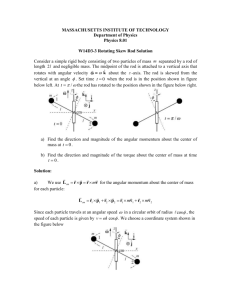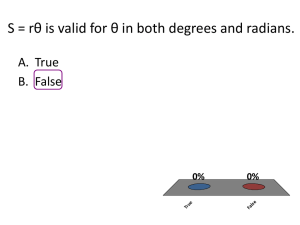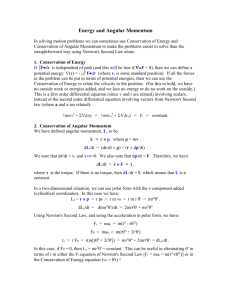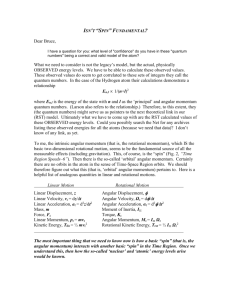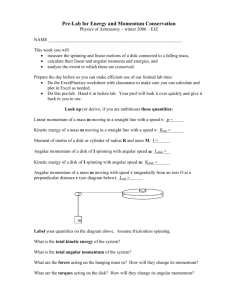MASSACHUSETTS INSTITUTE OF TECHNOLOGY
advertisement
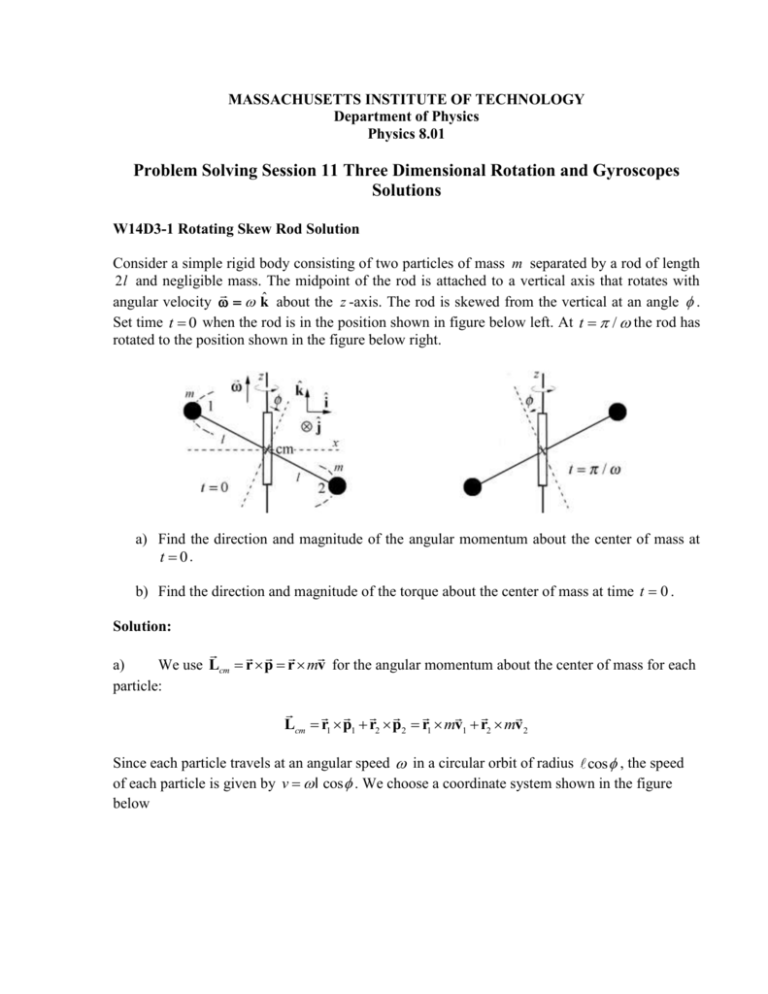
MASSACHUSETTS INSTITUTE OF TECHNOLOGY Department of Physics Physics 8.01 Problem Solving Session 11 Three Dimensional Rotation and Gyroscopes Solutions W14D3-1 Rotating Skew Rod Solution Consider a simple rigid body consisting of two particles of mass m separated by a rod of length 2l and negligible mass. The midpoint of the rod is attached to a vertical axis that rotates with angular velocity k̂ about the z -axis. The rod is skewed from the vertical at an angle . Set time t 0 when the rod is in the position shown in figure below left. At t / the rod has rotated to the position shown in the figure below right. a) Find the direction and magnitude of the angular momentum about the center of mass at t 0. b) Find the direction and magnitude of the torque about the center of mass at time t 0 . Solution: a) We use Lcm r p r mv for the angular momentum about the center of mass for each particle: Lcm r1 p1 r2 p2 r1 mv1 r2 mv2 Since each particle travels at an angular speed in a circular orbit of radius cos , the speed of each particle is given by v l cos . We choose a coordinate system shown in the figure below r r For particle 1: r1 l cos φ i l sin kφ and v1 l cos φ j . Thus r r r φ (ml cos φ L cm,1 r1 mv1 (l cos φ i l sin k) j) . After calculating the cross products, we have that the angular momentum about the center of mass for particle 1 is r L cm,1 ml 2 cos (cos kφ sin φ i) . Note that for particle 2, r2 r1 and v 2 v1 , so Lcm,2 r2 mv 2 r1 mv1 Lcm,1 . Thus the angular momentum about the center of mass at time t 0 is given by r Lcm (0) 2ml 2 cos(cos kφ sin φ i) . The magnitude of the angular momentum about the center of mass is given by Lcm 2ml 2 cos(cos2 sin2 ) 2ml 2 cos . b) At t 0 , the rod is rotating in the x y plane. The figure below shows the orientation of the rod as seen from above. The z -component of the angular momentum about the center of mass is constant and the x component of the angular momentum about the center of mass is changing in time as the rod rotates and is given by r L cm, x (0) 2ml 2 cos sin φ i The time derivative of the angular momentum about the center of mass is perpendicular the angular momentum, points in the positive y -direction, and has a magnitude that is equal to r L cm,x (0) . Therefore r r dL cm (0) L cm,x (0) φ j 2ml 2 2 cos sin φ j. dt The torque about the center of mass is given by Therefore at t 0 , we that r dL cm r cm dt r cm 2ml 2 2 cos sin φ j. W14D3-2 Table Problem Suspended Gyroscope Solution A gyroscope wheel is at one end of an axle of length d . The other end of the axle is suspended from a string of length s . The wheel is set into motion so that it executes uniform precession in the horizontal plane. The string makes a fixed angle with the vertical. The wheel has mass M and moment of inertia about its center of mass I cm . Its spin angular speed is . Neglect the mass of the shaft and the mass of the r string. Assume . What is the direction and magnitude precession angular velocity? of the Solution: We shall choose as our system the wheel and axle but not the string. The force diagram and coordinate system are shown in figure below. The torque on the wheel with respect to the center of mass of the wheel is given by cm rcm,T T , (1) In the coordinate system shown in figure below, rcm,T d î and T T sin î T cos ĵ . So the torque in Eq. (1) becomes cm d î (T sin î T cos ĵ) dT cos ( î ĵ) d T cos k̂ . (2) The direction of the torque is into the plane of figure (negative z-direction). This means that the direction of the change of the angular momentum of the spinning wheel is also into the plane the figure. Since the angular momentum is pointing outward (in the positive x-direction at the instant shown in the figure below on the lerft), the change in the angular momentum points in the negative z-direction as seen in the overhead view in the figure below on the right. The wheel will precess counterclockwise about the vertical axis. Denote the wheel’s precessional angular frequency by d / dt . Note we choose the angle to be increasing in the counterclockwise direction and so 0 . The spin angular momentum is directed along the axis of rotation and is equal in magnitude to the product of the moment of inertia about the center of mass and the spin angular velocity. At the instant depicted in the figure above, the angular momentum about the center of mass is Lcm I cm s î Lcm,z k̂ . (3) r dL cm φ . I cm s (k) dt (4) The time derivative is then Because cm dL cm , dt (5) substitute Eq. (2) into the left hand side of Eq. (5), and substitute Eq. (4) into the right hand side of Eq. (5) yielding, dT cos k̂ I cm s ( k̂) . (6) In Eq. (6), we have still not determined the tension of the string. We can use Newton’s Second Law applied to the center of mass F macm . (7) The weight of the wheel must be balanced by the vertical component of the force supplied by the string, T cos mg 0 . (8) Therefore the tension is T mg . cos (9) We can substitute Eq. (9) into Eq. (6) and solve for the precessional frequency, d mg . I cm s (10) Note that we are assuming the precession is uniform. This is our gyroscopic approximation and requires us to ignore any “nutational” effects as well as requiring that s . W14D3-1 Grain Mill Solution In a mill, grain is ground by a massive wheel that rolls without slipping in a circle on a flat horizontal mill stone driven by a vertical shaft. The rolling wheel has mass M , radius b and is constrained to roll in a horizontal circle of radius R at angular speed . The wheel pushes down on the lower mill stone with a force equal to twice its weight (normal force). The mass of the axle of the wheel can be neglected. Express your answers to the following questions in terms of R , b , M , , and g as needed. The goal of this problem is to find . a) What is the relation between the angular speed of the wheel about its axle and the angular speed about the vertical axis? b) Find the time derivative of the angular momentum about the joint (about the point P in r the figure above) dL P / dt . c) What is the torque about the joint (about the point P in the figure above? d) What is the value of ? Solution: The figure below shows the pivot point along with some convenient coordinate axes. For rolling without slipping, the speed of the center of mass of the wheel is related to the angular spin speed by vcm b . (11) Also the speed of the center of mass is related to the angular speed about the vertical axis associated with the circular motion of the center of mass by vcm R . (12) Therefore equating Eqs. (11) and (12) we have that R / b . (13) b) Assuming a uniform millwheel, I cm (1/ 2) Mb 2 , the magnitude of the horizontal component of the angular momentum about the center of mass is Lcm,h I cm 1 1 Mb 2 MRb . 2 2 (14) r The horizontal component of L cm is directed inward, and in vector form Lcm Lcm,h (rφ) in the above coordinate system. c) The axle exerts both a force and torque on the wheel, and this force and torque would be quite complicated. That’s why we consider the forces and torques on the axle/wheel combination. The normal force of the wheel on the ground is equal in magnitude to NWG 2mg so the third-law counterpart, the normal force of the ground on the wheel has the same magnitude NGW 2mg . The joint (or hinge) at point P therefore must exert a force FH,A on the end of the axle that has two components forces an inward force F2 to maintain the circular motion and a downward force F1 to reflect that the upward normal force is larger in magnitude than the weight. d) About point P , FH,A exerts no torque. The normal force exerts a torque of magnitude r NGW R 2mgR , directed out of the page, or, in vector form, P, N 2mgR φ . The weight exerts r a toque of magnitude MgR , directed into the page, or, in vector form, P,mg MgR φ. So the torque about P is r r r P P, N P,mg 2mgRφ MgR φ MgR φ. (15) As the wheel rolls, the horizontal component of the angular momentum about the center of mass will rotate, and the inward-directed vector will change in the negative φ -direction. Mathematically, r dLcm,h dt r φ 1 MRb( ) φ, Lcm,h ( ) 2 (16) where we used Eq. (14) for the magnitude of the horizontal component of the angular momentum about the center of mass. This is consistent with the torque about P pointing out of the page in the above figure. We can now apply the torque condition that P dLP dt (17) that becomes using Eqs. (15) and (16) φ 1 2 MRb( ) φ MgR( ) 2 (18) We can now solve Eq. (18) for the angular speed about the vertical axis 2g . b (19)


